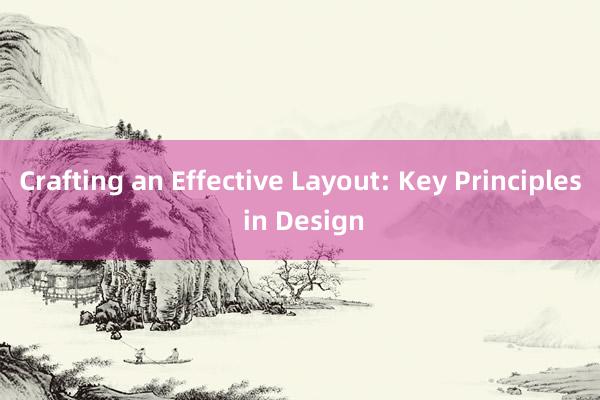
Crafting an Effective Layout: Key Principles in Design
新闻资讯
Crafting an Effective Layout: Key Principles in Design
发布日期:2024-10-22 12:48 点击次数:111

### Crafting an Effective Layout: Key Principles in Design
Design is the art of arranging elements in a way that is aesthetically pleasing and functional. An effective layout not only enhances visual appeal but also guides the user's experience, making information accessible and engaging. To achieve this, designers must adhere to several key principles:
#### 1. **Balance**
Balance ensures that the design feels stable and harmonious. It can be symmetrical (where elements are mirrored on either side) or asymmetrical (where elements are unevenly distributed but still feel balanced). The rule of thirds, dividing the design into thirds both horizontally and vertically, is a popular technique for achieving balance.
#### 2. **Hierarchy**
Hierarchy involves organizing elements based on their importance. This is typically achieved through size, color, and placement. Elements that are more important should be given prominence, guiding the viewer’s attention through the design in a logical sequence.
#### 3. **Contrast**
Contrast helps differentiate elements by varying aspects like color, size, and texture. High contrast makes elements stand out, aiding readability and making the design more visually appealing.
#### 4. **Repetition**
Repetition creates unity and rhythm within a design. By repeating elements such as shapes,木木青实业有限公司 colors, 福州市仓山区永全货运中介服务部 or fonts, 广州市海珠区银政纸类制品厂 designers can create a cohesive look and guide the eye smoothly across the page.
#### 5. **Proximity**
Proximity groups related elements together, making it easier for users to understand the structure of the design and the relationships between different parts. This principle helps in creating a clear and organized layout.
#### 6. **Alignment**
Alignment ensures that elements are arranged in a consistent manner, which contributes to a clean and professional look. Whether aligned to the left,拱玉软件 right, center, or justified, proper alignment improves readability and visual harmony.
#### 7. **White Space (Negative Space)**
White space, or negative space, refers to the areas around and between design elements. It is crucial for reducing clutter, enhancing readability, and improving the overall aesthetic appeal of the design.
#### 8. **Scale**
Scale involves adjusting the size of elements to reflect their importance. Larger sizes can draw attention, while smaller sizes can provide detail or background information without overwhelming the primary focus.
#### 9. **Focus**
Creating a focal point draws attention to the most important part of the design. This could be a headline, an image, or a call-to-action element. Ensuring there is one dominant focal point helps maintain viewer engagement.
#### 10. **Flexibility**
Designs should be adaptable to various contexts, such as different screen sizes or orientations. Responsive design techniques ensure that the layout remains effective and readable across multiple platforms.
洁具制造有限公司|冷热水龙头|水龙头厂家|厨房水龙头|淋浴水龙头By integrating these principles拱玉软件, designers can create layouts that are not only visually appealing but also functional and user-friendly. Each principle plays a critical role in achieving a balanced, organized, and engaging design that effectively communicates its intended message.